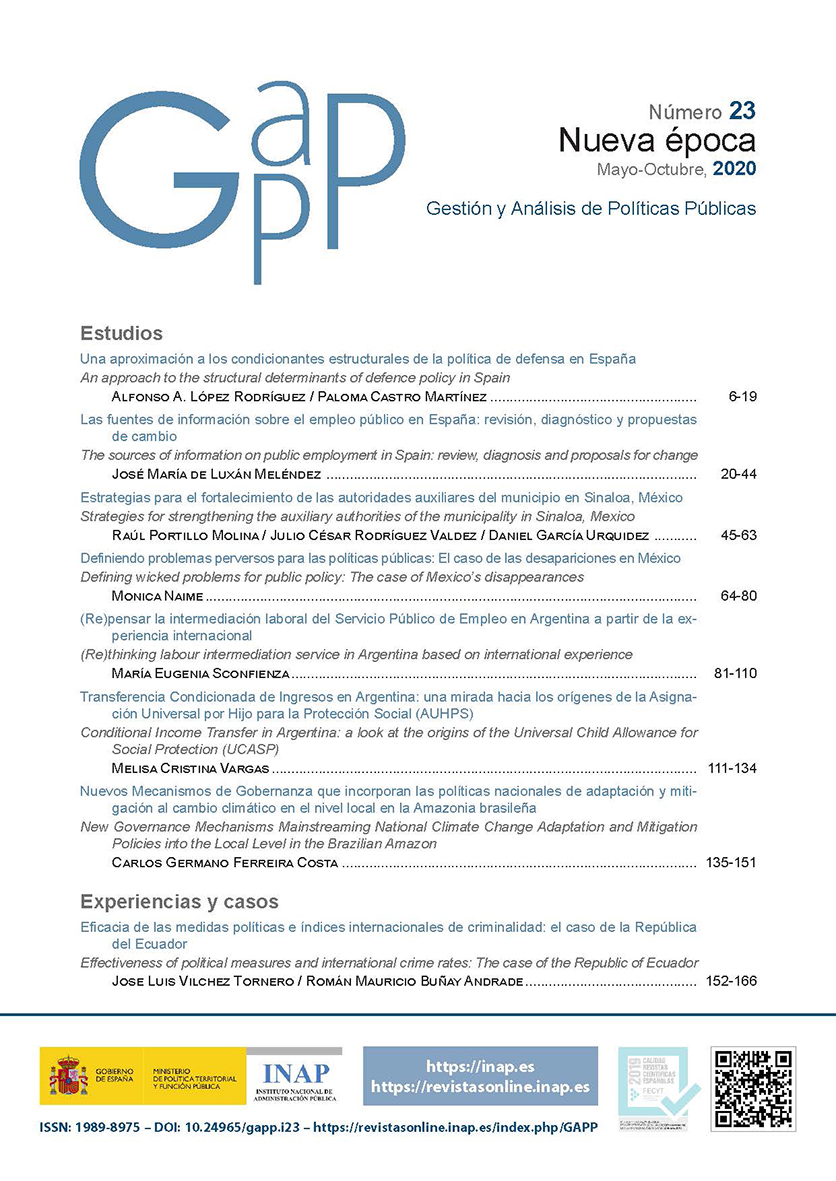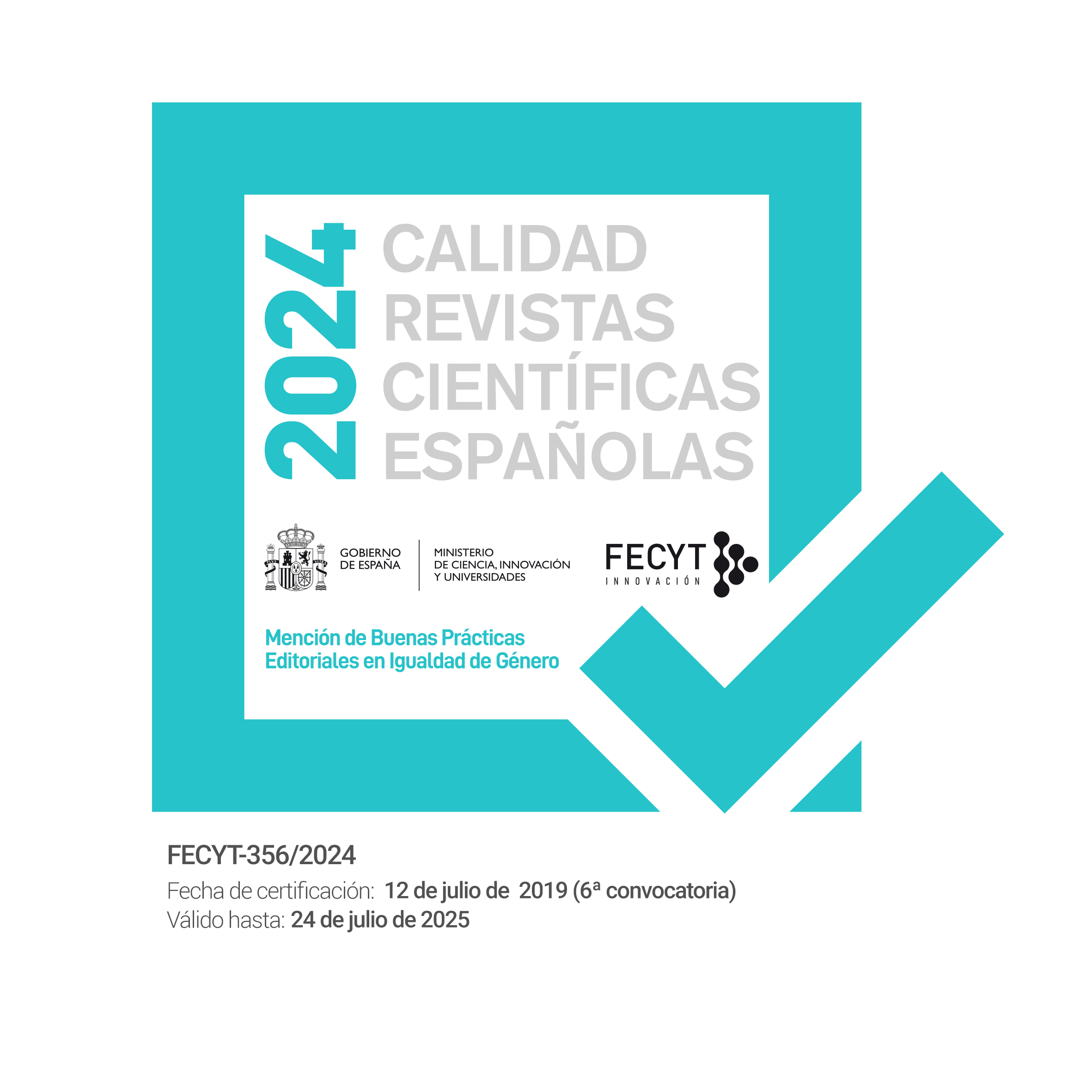Defining wicked problems for public policy: The case of Mexico’s disappearances
DOI:
https://doi.org/10.24965/gapp.i23.10648Keywords:
Wicked problems, public policy, problem definition, public administration, disappearancesAbstract
Wicked problem literature is increasingly popular, but empirical studies about its relation to public policy are scarce. Additionally, there is no consensus on the convenience of Public Administration as policy makers addressing wicked problems by artificially defining and structuring them. The purpose of the paper is to address these gaps, specifically how, in practice, governments handle wicked problems. Two possible alternatives are discussed: either policy makers are rational, or rather they use heuristics for problem definition. The research focuses on problem definition as part of the policy process. In particular, how the definition of the particular wicked problematic situation was reflected in legislation: disappearances in Mexico. The case shows that forced disappearances is an heterogeneous phenomenon that can be considered a wicked problem, which further increases the complexity of policies that aim to tackle it. Also, results of applying congruence tests show that policy-makers structure wicked problems when defining them, but after a certain amount of energy has been spent on this task, policy makers employ heuristic devices. This contributes to understand how flesh and bone decision-makers build public policies.
Downloads
References
AIDOO, A. (1993): “Africa: Democracy Without Human Rights?”, in Human Rights Quarterly, vol. 15, no. 4, pp. 703-715. Retrieved from: https://www.jstor.org/stable/762403. DOI: https://doi.org/10.2307/762403.
ALFORD, J., & HEAD, B. W. (2017): “Wicked and less wicked problems: a typology and a contingency framework”, in Policy and Society, vol. 36, no. 3, pp. 397-413. DOI: https://doi.org/10.1080/14494035.2017.1361634.
ALLEN, G. M., & GOULD JR., E. M. (1986): “Complexity, Wickedness and Public Forests”, in Journal of Forestry, vol. 84, no. 4, pp. 20-23. DOI: https://doi.org/10.1093/jof/84.4.20.
ANGEL, A. (2016): “Peña duplica el número de militares en las calles, aunque ninguna ley los regula”, in Animal Político (30-05-2019). Retrieved from: https://www.animalpolitico.com/2016/10/pena-nieto-militares-seguridad-publica/.
ANGEL, A. (2018): “Operativo Tiro de Gracia: Detienen a cúpula de la policía de Javier Duarte por desaparición forzada”, in Animal Político (30-05-2019). Retrieved from: https://www.animalpolitico.com/2018/02/detienen-policia-javier-duarte-desaparicion-forzada-15-personas/.
ANIMAL POLÍTICO (2018): “Investigación apunta a que Javier Duarte estuvo implicado en desapariciones: Yunes”, in Animal Político (14-05-2018). Retrieved from: https://www.animalpolitico.com/2018/05/investigacion-duarte-implicado-desapariciones/.
ANSOLABEHERE, K., FREY, B., & PAYNE, L. (2017): “La constitución de la desaparición forzada. Vínculos entre los significados legales y sociales de la desaparición”, in YANKELEVICH, J. (coord.): Desde y Frente al Estado: Pensar, atender y resistir la desaparición de personas en México. Mexico City: Centro de Estudios Constitucionales de la Suprema Corte de Justicia de la Nación.
ARQUIDIOCESIS DE SAO PAULO (1985): Brasil: Nunca mais. Retrieved from: http://dhnet.org.br/memoria/nuncamais/index.htm.
BENDOR, J. (2015): “Incrementalism: Dead yet Flourishing”, in Public Administration Review, vol. 75, no. 2, pp. 194-205. DOI: http://doi.org/10.1111/puar.12333.
BOUCKAERT, G., PETERS, B. G., & VERHOEST, K. (2010): The Coordination of Public Sector Organizations: Shifting Patterns of Public Management. Basingstoke, UK: Palgrave Macmillan.
BRIGGS, L. (2007): Tackling Wicked Problems: A Public Policy Perspective. Canberra: Australian Public Service Commission. Retrieved from: https://www.apsc.gov.au/tackling-wicked-problems-public-policy-perspective.
BURGE, J. E., & MCCALL, R. (2014): “Diagnosing Wicked Problems”, in GERO, J. S., & HANNA, S. (eds.): Design Computing and Cognition ‘14, pp. 313-326. Cham: Springer. DOI: https://doi.org/10.1007/978-3-319-14956-1.
CAMILLUS, J. C. (2008): “Strategy as a Wicked Problem”, in Harvard Business Review, no. May. Retrieved from: https://hbr.org/2008/05/strategy-as-a-wicked-problem.
CENTRO PRODH (2018): 10 preguntas clave sobre la Ley en materia de desaparición forzada de personas, desaparición por particulares y del sistema nacional de búsquedas. Retrieved from: http://centroprodh.org.mx/wp-content/uploads/2018/12/Cartilla_LDF_Full.pdf.
CHRISTENSEN, T., LÆGREID, P., RONESS, P. G., & RØVIK, K. A. (2007): Organization Theory and the Public Sector: Instrument, Culture and Myth. London: Routledge.
CHURCHMAN, C. W. (1967): “Guest Editorial: Wicked Problems”, in Management Science, vol. 14, no. 4, pp. 141-142. Retrieved from: http://www.jstor.org/stable/2628678.
COMISIÓN MEXICANA DE DEFENSA Y PROMOCIÓN DE LOS DERECHOS HUMANOS (CMDPDH) (2018): Este sexenio tiene los más altos índices de desaparición de niños, niñas y adolescentes; México sin políticas públicas eficaces para asistir a esta población. Retrieved from: http://cmdpdh.org/2018/04/este-sexenio-tiene-los-mas-altos-indices-de-desaparicion-de-ninos-ninas-y-adolescentes-mexico-sin-politicas-publicas-eficaces-para-asistir-a-esta-poblacion/.
COMISIÓN NACIONAL DE LOS DERECHOS HUMANOS (CNDH) (2017): Informe Especial de la Comisión Nacional de los Derechos Humanos sobre desaparición de personas y fosas clandestinas en México. Retrieved from: http://informe.cndh.org.mx/menu.aspx?id=30100.
COMISION NACIONAL DE VERDAD Y RECONCILIACION (COMISION RETTIG) (1996): Informe de la Comisión Nacional de Verdad y Reconciliación, tomo 1. Retrieved from: http://www.derechoshumanos.net/lesahumanidad/informes/Informe-Rettig-tomo1.pdf.
COMISIÓN NACIONAL SOBRE LA DESAPARICIÓN DE PERSONAS (CONADEP) (1984): Nunca más: Informe final. Retrieved from: http://www.derechoshumanos.net/lesahumanidad/informes/argentina/informe-de-la-CONADEP-Nunca-mas.htm.
COMVERDAD (2014): Comisión de la Verdad del Estado de Guerrero: Informe final de actividades. Retrieved from: http://congresogro.gob.mx/files/InformeFinalCOMVERDAD.pdf.
CONKLIN, J. (2006): Dialogue Mapping: Building Shared Understanding of Wicked Problems. New York, NY: John Wiley & Sons, Inc.
COURTNEY, J. F. (2001): “Decision making and knowledge management in inquiring organizations: Toward a new decision-making paradigm for DSS”, in Decision Support Systems, vol. 31, no. 1, pp. 17-38. DOI: https://doi.org/10.1016/S0167-9236(00)00117-2.
DANKEN, T. (2017): Coordination of Wicked Problems. Comparing inter-departmental coordination of demographic change policies in five German states, PhD Dissertation. Germany: University of Potsdam, Faculty of Economic and Social Sciences. Available at: http://nbn-resolving.de/urn:nbn:de:kobv:517-opus4-396766.
DAVENPORT, C., & ARMSTRONG II, D. A. (2004): “Democracy and the Violation of Human Rights”, in American Journal of Political Science, vol. 48, no. 3, pp. 538-554. DOI: https://doi.org/10.1111/j.0092-5853.2004.00086.x.
DAVITER, F. (2017): “Coping, taming or solving: alternative approaches to the governance of wicked problems”, in Policy Studies, vol. 38, no. 6, pp. 571-588. DOI: https://doi.org/10.1080/01442872.2017.1384543.
DAVITER, F. (2019): “Policy analysis in the face of complexity: What kind of knowledge to tackle wicked problems?”, in Public Policy and Administration, vol. 34, no. 1, pp. 62-83. DOI: https://doi.org/10.1177/0952076717733325.
DIAZ, G. L. (2018): “Tamaulipas: tres meses de terror bajo el yugo de la Marina”, in Proceso (30-05-2019). Retrieved from: https://www.proceso.com.mx/533485/tamaulipas-tres-meses-de-terror-bajo-el-yugo-de-la-marina.
FISCALÍA ESPECIAL PARA MOVIMIENTOS SOCIALES Y POLÍTICOS DEL PASADO (FEMOSPP) (2006): Informe Documenta sobre 18 años de “Guerra Sucia” en México. Retrieved from: https://nsarchive2.gwu.edu//NSAEBB/NSAEBB180/index2.htm.
FINUCANE, B. (2010): “Enforced Disappearance as a Crime Under International Law: A Neglected Origin in the Laws of War”, in Yale Journal of International Law, vol. 35, no. 1, pp. 171-197. Retrieved from: https://digitalcommons.law.yale.edu/yjil/vol35/iss1/5/.
GALINDO, C., RAMÍREZ, S., & RODRÍGUEZ, J. M. (2019): “Historia, retos de mejora y cifras del registro de personas desaparecidas”, in Temas Estratégicos, no. 70. Retrieved from: http://bibliodigitalibd.senado.gob.mx/handle/123456789/4434.
GIGERENZER, G., & SELTEN, R. (eds.) (2001): Bounded Rationality: The Adaptive Toolbox. Cambridge: MIT Press.
GRIFFIN, C., & RUIZ, J. (1999): “The sociopathic police personality: Is it a product of the «Rotten Apple» or the «Rotten Barrel»?”, in Journal of Police and Criminal Psychology, March, vol. 14, no. 1, pp. 28-37. DOI: https://doi.org/10.1007/BF02813860.
GRINT, K. (2010): “Wicked Problems and Clumsy Solutions: The Role of Leadership”, in BROOKES, S., & GRINT, K. (eds.): The New Public Leadership Challenge, pp. 169-186. London, UK: Palgrave Macmillan. DOI: https://doi.org/10.1057/9780230277953_11.
GUEVARA ROSAS, E. (2018): “Las muertes en México: ¿Daños colaterales o el producto de una política de seguridad fallida?”, in Amnesty International (30-05-2019). Retrieved from: https://www.amnesty.org/es/latest/news/2018/04/las-muertes-en-mexico-danos-colaterales-o-el-producto-de-una-politica-de-seguridad-fallida/.
HEAD, B. W. (2008): “Wicked Problems in Public Policy”, in Public Policy, vol. 3, no. 2, pp. 101-118. DOI: https://doi.org/10.1128/MCB.00567-07.
HEAD, B. W. (2018): “Forty years of wicked problems literature: forging closer links to policy studies”, in Policy and Society, vol. 38, no. 2, pp.180-197. DOI: https://doi.org/10.1080/14494035.2018.1488797.
HEAD, B. W., & ALFORD, J. (2008): “Wicked problems: The implications for public management”, in Panel on Public Management in Practice. Retrieved from: http://www.irspm2008.bus.qut.edu.au/papers/documents/pdf2/Head-WickedProblemsHeadAlfordFinal250308.pdf.
HOPPE, R. (2010): The governance of problems: Puzzling, powering, and participation. Bristol: The Policy Press.
HUNTER, B. H. (2007): “Conspicuous Compassion and Wicked Problems The Howard Government ́s National Emergency in Indigenous Affairs”, in Agenda: A Journal of Policy Analysis and Reform, vol. 14, no. 3, pp. 35-51.
INFOBAE (2019): “El número de militares en las calles de México incrementó con López Obrador al mando”, in Infobae (30-05-2019). Retrieved from: https://www.infobae.com/america/mexico/2019/04/09/el-numero-de-militares-en-las-calles-de-mexico-incremento-con-lopez-obrador-al-mando/.
INTERAMERICAN COMMISSION ON HUMAN RIGHTS (IACHR) (2015): Situación de derechos humanos en México. Retrieved from: http://www.oas.org/es/cidh/informes/pdfs/mexico2016-es.pdf.
INTERAMERICAN COMMISSION ON HUMAN RIGHTS (IACHR) (2018): Informe del Mecanismo Especial de Seguimiento al Asunto Ayotzinapa. Retrieved from: http://www.oas.org/es/cidh/informes/pdfs/MESA-es.pdf.
INTERAMERICAN COURT OF HUMAN RIGHTS (IACOHR) (2009): Rosendo Radilla vs. México. Excepciones Preliminares, Fondo, Reparaciones y Costas. Sentencia de 23 de noviembre de 2009. Serie C, no. 209.
INTERNATIONAL COMMITTEE OF THE RED CROSS (ICRC) (2015): Elementos Esenciales para Regular la Desaparición de Personas: documento de trabajo. Retrieved from: https://www.acnur.org/fileadmin/Documentos/BDL/2015/10093.pdf.
INTERNATIONAL COMMITTEE OF THE RED CROSS (ICRC) (2017): México: promulgación de una ley general para prevenir la desaparición de personas y responder a las necesidades de los familiares de personas desaparecidas (16-11-2017). Retrieved from: https://www.icrc.org/es/document/mexico-promulgacion-de-una-ley-general-para-prevenir-la-desaparicion-de-personas-y.
KHADEMIAN, A. M., & WEBER, E. P. (2008): “Wicked Problems, Knowledge Challenges, and Collaborative Capacity Builders in Network Settings”, in Public Administration Review, vol. 68, no. 2, pp. 334-349. DOI: https://doi.org/10.1111/j.1540-6210.2007.00866.x.
KLIJN, E. H., & KOPPENJAN, J. F. M. (2014): “Complexity in Governance Network Theory”, in Complexity, Governance & Networks, vol. 1, no. 1, pp. 61-70. DOI: https://doi.org/10.7564/14-CGN8.
KRAMER, F. D. (2011): “Irregular Conflict and the Wicked Problem Dilemma: Strategies of Imperfection”, in PRISM, vol. 2, no. 3, pp. 75-100. Retrieved from: https://www.jstor.org/stable/26469133.
KREUTER, M. W., DE ROSA, C., HOWZE, E. H., & BALDWIN, G. T. (2004): “Understanding Wicked Problems: A Key to Advancing Environmental Health Promotion”, in Health Education & Behavior, vol. 31, no. 4, pp. 441-454. DOI: https://doi.org/10.1177/1090198104265597.
LÆGREID, P., & RYKKJA, L. H. (2015): “Organizing for «wicked problems» – analyzing coordination arrangements in two policy areas”, in International Journal of Public Sector Management, vol. 28, no. 6, pp. 475-493. DOI: https://doi.org/10.1108/IJPSM-01-2015-0009.
LE CLERQ ORTEGA, J. A., & RODRIGUEZ SANCHEZ LARA, G. (coords.) (2017): Global Impunity Dimensions: GII-2017 Global Impunity Index. Retrieved from: www.udlap.mx/cesij.
LINARES, J. R. (2019): “Marco Antonio, estudiante de Prepa 8, fue víctima de desaparición forzada: tribunal”, in Proceso (30-05-2019). Retrieved from: https://www.proceso.com.mx/585046/marco-antonio-estudiante-de-prepa-8-fue-victima-de-desaparicion-forzada-tribunal.
LINDBLOM, C. E. (1959): “The Science of «Muddling» Through”, in Public Administration Review, vol. 19, no. 2, pp. 79-88.
LINDBLOM, C. E. (1979): “Still Muddling, Not Yet Through”, in Public Administration Review, vol. 39, no. 6, pp. 517-526. DOI: https://doi.org/10.2307/976178.
LUSTICK, I. (1980): “Explaining the Variable Utility of Disjointed Incrementalism: Four Propositions”, in The American Political Science Review, vol. 74, no. 2, pp. 342-353. Retrieved from: https://www.jstor.org/stable/1960631.
MAJONE, G. (1989): Evidence, argument, and persuasion in the policy process. New Haven: Yale University Press.
MARTÍNEZ, C. (2018). “Aumenta en un 60% desaparición forzada”, in Reforma. Retrieved from: http://www.reforma.com/aplicaciones/articulo/default.aspx?id=1338799.
MCCALL, R., & BURGE, J. (2016): “Untangling wicked problems”, in Artificial Intelligence for Engineering Design, Analysis and Manufacturing, vol. 30, no. 2, pp. 200-210. DOI: https://doi.org/10.1017/S089006041600007X.
MCCONNELL, A. (2018): “Rethinking wicked problems as political problems and policy problems”, in Policy & Politics, vol. 46, no. 1, pp. 165-180. DOI: https://doi.org/10.1332/030557317X15072085902640.
MERRY, S. E. (2016): The Seductions of Quantification: Measuring Human Rights, Gender Violence, and Sex Trafficking. Chicago: University of Chicago Press (Chicago Series in Law and Society).
MERRY, S. E., DAVIS, K., & KINGSBURY, B. (eds.) (2015): The Quiet Power of Indicators: Measuring Governance, Corruption, and Rule of Law. Cambridge: Cambridge University Press (Cambridge Studies in Law and Society). DOI: https://doi.org/10.1017/CBO9781139871532.
MEZA, O.; CORONA, G. (2018): Wicked Problems, Ready or Not?: A Comparative Overview on the Policy Preparedness to Address the Drug Policy Problem. Working paper for the International Society for the Study of Drug Policy (ISSDP). Vancouver, Canada, 16-18 May 2018, 27.
NATIONAL COMMISSION FOR HUMAN RIGHTS (CNDH) (2001): Recomendacion 26. Casos sobre las quejas en materia de desapariciones forzadas ocurridas en la década de los 70 y principios de los 80. Retrieved from: http://www.cndh.org.mx/sites/all/doc/Recomendaciones/2001/Rec_2001_026.pdf.
NEWMAN, J., & HEAD, B. W. (2017): “Wicked tendencies in policy problems: Rethinking the distinction between social and technical problems”, in Policy and Society, vol. 36, no. 3, pp. 414-429. DOI: http://doi.org/10.1080/14494035.2017.1361635.
OFFICE OF THE UNITED STATES CHIEF OF COUNSEL FOR PROSECUTION OF AXIS CRIMINALITY (US-OPAC) (1941): “Document No. L-90”, in Nazi Conspriracy and Aggression, Volume 7. Retreived from The Avalon Project: https://avalon.law.yale.edu/imt/l-90.asp.
OFFICIAL GAZETTE OF THE STATE OF GUERRERO (2012): Ley Número 932 Por la que se crea la Comisión de la Verdad para la Investigación de las Violaciones a los Derechos Humanos durante la Guerra Sucia de los Años Sesenta y Setentas del Estado de Guerrero. Retrieved from: http://congresogro.gob.mx/61/attachments/article/628/%EF%83%96LEY%20NO.%20932%20CREA%20LA%20COMISION%20DE%20LA%20VERDAD%20(19-DIC-11).pdf.
OFFICIAL JOURNAL OF THE FEDERATION (OJF) (2001): Acuerdo por el que se disponen diversas medidas parala procuración de justicia por delitos cometidos contra personas vinculadas con movimientos sociales y políticos del pasado. Retrieved from: http://www.dof.gob.mx/nota_detalle.php?codigo=758894&fecha=27/11/2001.
OFFICIAL JOURNAL OF THE FEDERATION (OJF) (2007): Acuerdo A/317/06 del Procurador General de la República. Retrieved from: http://www.dof.gob.mx/nota_detalle.php?codigo=4966412&fecha=26/03/2007.
OFFICIAL JOURNAL OF THE FEDERATION (OJF) (2012): Ley del Registro Nacional de Datos de Personas Extraviadas o Desaparecidas. (17-04-2012). Retrieved from: http://www.diputados.gob.mx/LeyesBiblio/abro/lrndped.htm.
OFFICIAL JOURNAL OF THE FEDERATION (OJF) (2017): Ley General en materia de desaparición forzada de personas, desaparición cometida por particulares y del Sistema Nacional de Búsqueda de Personas. (17- 01-2017). Retrieved from: http://www.diputados.gob.mx/LeyesBiblio/pdf/LGMDFP_171117.pdf.
ORGANIZATION OF AMERICAN STATES (OAS) (1994): Inter-American Convention on Forced Disappearance of Persons. Retrieved from: https://www.oas.org/juridico/english/treaties/a-60.html.
PAL, L. A. (2011): “Assessing incrementalism: Formative assumptions, contemporary realities”, in Policy and Society, vol. 30, no. 1, pp. 29-39. DOI: http://doi.org/10.1016/j.polsoc.2010.12.004.
PETERS, B. G. (2017): “What is so wicked about wicked problems? A conceptual analysis and a research program”, in Policy and Society, vol. 36, no. 3, pp. 385-396. DOI: https://doi.org/10.1080/14494035.2017.1361633.
RITTEL, H. W. J. (1972): “On the Planning Crisis: Systems Analysis of the «First and Secon Generations»” in Bedriftskonomen, vol. 8, pp. 390-396.
RITTEL, H. W. J., & WEBBER, M. M. (1973): “Dilemmas in a General Theory of Planning”, in Policy Sciences, vol. 4, no. 2, pp. 155-169.
ROBERTS, N. (2000): “Wicked Problems and Network Approaches to Resolution”, in International Public Management Review, vol. 1, no. 1, pp. 1-19. Retrieved from: http://journals.sfu.ca/ipmr/index.php/ipmr/article/view/175.
ROJAS, A. G. (2018): “El dramático «caso Alvarado» que llevó a la Corte IDH a juzgar por primera vez a México por desapariciones forzadas”, in BBC Mundo (27-04-18). Retrieved from: http://www.bbc.com/mundo/noticias-america-latina-43921261.
SALDÍVAR ARREOLA, R. & RODRÍGUEZ SÁNCHEZ, I. (2018): “Análisis del léxico en diferentes registros textuales en la construcción del imaginario social del narcotráfico en México”, in Literatura y Lingüística, no. 37, pp. 381-400. DOI: https://doi.org/10.29344/0717621X.37.1388.
SALWASSER, H. (2004): “Confronting the implications of wicked problems: changes needed in Sierra Nevada National Forest planning and problem solving”, in MURPHY, P. A., DENNIS, D., STINE, P. A. (eds.): Proceedings of the Sierra Nevada Science Symposium Gen. Tech. Rep. PSW-GTR-193, pp. 7-22. Albany, CA: Pacific Southwest Research Station, Forest Service, U.S. Department of Agriculture.
SARTORI, G. (1970): “Concept Misformation in Comparative Politics”, in American Political Science Review, vol. 64, no. 4, pp. 1033-1053. DOI: https://doi.org/10.2307/1958356.
SECCHI, D. (2011): Extendable Rationality: Understanding Decision Making in Organizations. New York, NY: Springer. DOI: http://doi.org/10.1007/978-1-4419-7542-3.
SECRETARIADO EJECUTIVO DEL SISTEMA NACIONAL DE SEGURIDAD PÚBLICA (SESNSP) (2018): Registro Nacional de Personas Extraviadas y Desaparecidas. Retrieved from: http://www.secretariadoejecutivo.gob.mx/rnped/consulta-publica.php.
SIMON, H. A. (1973): “The structure of ill structured problems”, in Artificial Intelligence, vol. 4, no. 3-4, pp. 181-201. DOI: https://doi.org/10.1016/0004-3702(73)90011-8.
SIMON, H. A. (1996): The sciences of the artificial. Cambridge: MIT Press (Third Ed.).
STONE, D. (2012): Policy Paradox: The Art of Political Decision Making. New York: W. W. Norton & Company (Third Ed.).
SUNSTEIN, C. R. (2014): “Nudges.gov: Behavioral Economics and Regulation”, in ZAMIR, E., & TEICHMAN, D. (eds.): The Oxford Handbook of Behavioral Economics and the Law. Oxford: Oxford University Press.
THALER, R. H., & SUNSTEIN, C. R. (2008): Nudge: improving decisions about health, wealth, and happiness. New Haven: Yale University Press.
UNITED NATIONS (UN) (2019): Committee on Enforced Disappearances. (31-05-2019). Retrieved from: https://www.ohchr.org/EN/HRBodies/CED/Pages/CEDIndex.aspx.
UNITED NATIONS GENERAL ASSEMBLY (UNGA) (2015): Transforming our world: the 2030 Agenda for Sustainable Development, 21 October 2015, A/RES/70/1. Retrieved from: https://www.un.org/ga/search/view_doc.asp?symbol=A/RES/70/1&Lang=E.
UNITED NATIONS GENERAL ASSEMBLY (UNGA) (1998): Rome Statute of the International Criminal Court (last amended 2010), 17 July 1998. International Criminal Court. Retrieved from: https://www.icc-cpi.int/resource-library/documents/rs-eng.pdf.
UNITED NATIONS GENERAL ASSEMBLY (UNGA) (2006): International Convention for the Protection of All Persons from Enforced Disappearance. Retrieved from: https://www.ohchr.org/en/hrbodies/ced/pages/conventionced.aspx.
UNITED NATIONS (UN) (2015): La desaparición forzada en México: una mirada desde los organismos del Sistema de Naciones Unidas. México: Office of the High Commissioner for Human Rights, National Commission for Human Rights City. Retrieved from: https://www.hchr.org.mx/images/20151022_DesapForz_IBA_ONUDH_WEB.pdf.
VAUGHAN, D. (1996): The Challenger Launch Decision: Risky Technology, Culture and Deviance at NASA. Chicago: The University of Chicago Press.
VILLALOBOS, A. (2018): “Caso Marco Antonio: Crónica de una desaparición forzada”, in Proceso (05-02-2018). Available at: https://www.proceso.com.mx/521339/caso-marco-antonio-cronica-de-una-desaparicion-forzada.
WEICK, K. E. (2005): “Organizing and Failures of Imagination”, in International Public Management Journal, vol. 8, no. 3, pp. 425-438. DOI: http://doi.org/10.1080/10967490500439883.
WILSON, J. Q. (2013): Thinking about Crime. New York: Basic Books.
WORLD BANK (2017): “Homicidios intencionales (por cada 100.000 habitantes)”, in Base de datos de Estadísticas de homicidios internacionales de la Oficina de las Naciones Unidas contra la Droga y el Delito (11-01-2019). Available at: https://datos.bancomundial.org/indicador/VC.IHR.PSRC.P5?locations=MX&view=chart.
XIANG, W. N., & HEAD, B. W. (2013): “Working with wicked problems in socio-ecological systems: Awareness, acceptance, and adaptation”, in Landscape and Urban Planning, vol. 110, no. 1, pp. 1-4. DOI: https://doi.org/10.1016/j.landurbplan.2012.11.006.
YU, Y. (2016): “Do Democratic Institutions Reduce Human Rights Violations or Just Prevent More Violations than Current Levels? An Exogenous Explanation of Human Rights Improvements in Democracies”, in The Koream Journal of International Studies, vol. 14, no. 3, pp. 415-446. DOI: https://doi.org/10.14731/kjis.2016.12.14.3.415.
ZAVALETA, N. (2018): “Fiscalía de Veracruz suma acusación contra Javier Duarte; ahora por desaparición forzada”, in Proceso (30-05-2019). Available at: https://www.proceso.com.mx/537566/fiscalia-de-veracruz-suma-acusacion-contra-javier-duarte-ahora-por-desaparicion-forzada.
ZIMBARDO, P. G. (2007): The Lucifer Effect: Understanding How Good People Turn Evil. New York: Random House.












